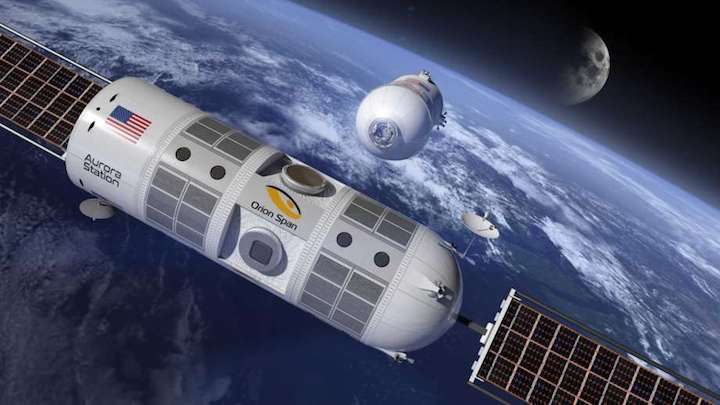6.04.2018



Houston, the city that put men on the moon, may put a hotel in outer space.
For $9.5 million — including an $80,000 upfront deposit — space tourists would be able to float in zero gravity, grow food to take home as a souvenir and see 16 sunrises and sunsets every 24 hours aboard a modular space station that was announced Thursday during a California space summit. The first trip could come in just four years.
VISION: NASA posters imagine the world of space tourism
The luxurious Aurora Station is the brainchild of Orion Span, a space technology company based in Houston and Silicon Valley. The low-Earth-orbit hotel would be manufactured in the Clear Lake area, capitalizing on local expertise in human spaceflight. Tourists would train for their trip here as well.
“Houston is by far the best place in the world for human spaceflight and human spaceflight development,” Orion Span CEO Frank Bunger said in a telephone interview after the Space 2.0 Summit in San Jose, Calif.
While the pricetag for the 12-day journey may sound beyond the reach of most Houstonians, Bunger said it’s more affordable than previous space tourism experiences. And he aims to bring the price down further.
“We want to make space accessible to regular individuals on average incomes,” he said.
Bunger declined to say whether he picked up any trip deposits following Thursday’s announcement.
Prior to take-off, Aurora Station guests will participate in a three-month certification program. Part of this will be completed online, and the remainder will be completed in a Houston training facility that, like the station itself, has yet to be built.
Still, Orion Span announced plans to launch Aurora Station in late 2021. The 43.5-foot-long hotel would have a diameter of 14.1 feet. It would not require assembly or inflation upon entering zero gravity, and could go into service immediately.
The company hopes to host its first guests in 2022.
Bunger said the company is evaluating a few different launch providers, including SpaceX, Blue Origin and international space agencies.
The project is expected to cost tens of millions of dollars. It’s currently self-funded with two angel investors, though Orion Span intends to launch a Series A round of financing in the next few months.
Bunger, who lives in the San Francisco Bay area, has a technology background. But others on his team have many years of space experience in Houston.
The team includes chief technology officer David Jarvis, a human spaceflight engineer and payload developer with knowledge in the management and operations of the International Space Station; chief architect Frank Eichstadt, an industrial designer and principal architect on the ISS Enterprise module; and chief operating officer Marv LeBlanc, a former general manager and program manager with decades of experience running operations and mission control.
Aurora Station won’t be limited to tourism, either. Space agencies around the world may find it a more affordable way to access space. It could also support zero gravity research and space manufacturing.
Quelle: Chron
---
Update: 7.04.2018
.
The World’s First Floating Space Hotel Is Coming
Slated to open in 2021, Aurora Station is now taking reservations.
Ever since Apollo 14 astronaut Alan Shepard sent a golf ball soaring through outer space from the surface of the moon, intrepid travelers have been anxiously waiting for space tourism to take off. But the industry—for lack of funding and technology but certainly not for lack of interest—has suffered from a near-universal failure to launch.
At last, however, it appears that space may soon be within reach, with SpaceX already successfully launching seven rockets this year—and Blue Origin and Virgin Galactic making strides of their own. Turning the prospect of space travel into more than a mere joyride, meanwhile, is Orion Span, a new company that claims to be building the first-ever “luxury space hotel.”
Aurora Station is perhaps better described as a modular space station than a hotel, featuring just four guest suites and measuring a total of only 455 square feet (that’s roughly the size of a Gulfstream G550). A crew of two will host the interstellar visitors on 12-day journeys, leading them in research and experiments—such as growing fruits and vegetables—and introducing them to day-to-day life on a space station.
“The premise of Aurora Station is for guests to live, feel, and breath what it’s like to be an astronaut,” says Frank Bunger, CEO of Orion Span. That means 24/7 weightlessness—and plenty of freeze-dried food and Tang, too. “It’s not going to be five-star dining,” Bunger warns. “Fire and gas don’t work the same way in space as they do on Earth.”

Orion Span’s Aurora Station Space Hotel Photo: Courtesy Orion Span
But with the hotel orbiting at 200 miles above the Earth’s surface and going around the Earth every 90 minutes, food will likely be the last thing on anyone’s mind. “People will spend more time looking out the window than anything else,” Bunger predicts.
Guests will travel from Earth to Aurora Station via a 30-minute rocket flight. (Orion Span has yet to officially partner with a spaceflight company, but Bunger says the company is currently in talks with SpaceX and Blue Origin, among other companies). Prior to launch, every visitor will undergo a health screening and three months of training—a tall order for most luxury vacations, but relatively short compared with the 24 months NASA requires of its astronauts. Even more prohibitive will be the price: Reservations—which open today—start at $9.5 million per person. But, Burger notes, that might not be the case for long.
“I think by the mid-2020s, we’re going to see quite a bit of possibilities for getting up there, and the cost going down,” he says. “Our core mission is ultimately to get more people to space—and eventually live in space.” Space condos—and golf courses—here we come.
Quelle: Robb Report
